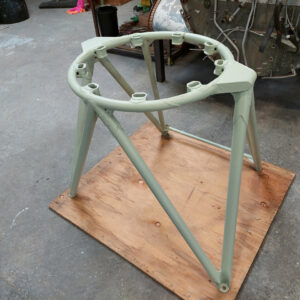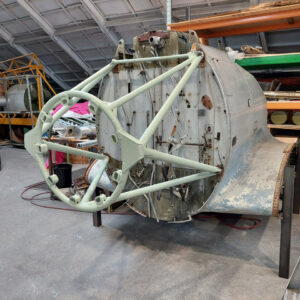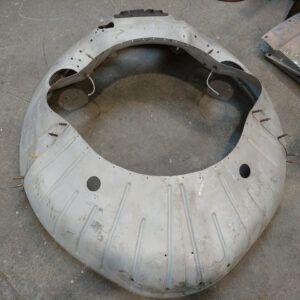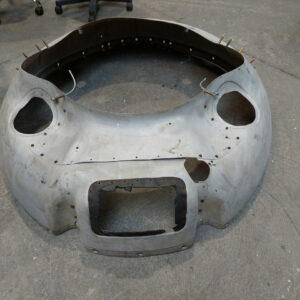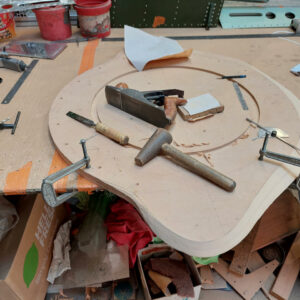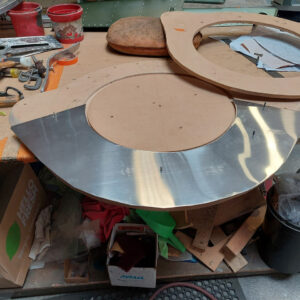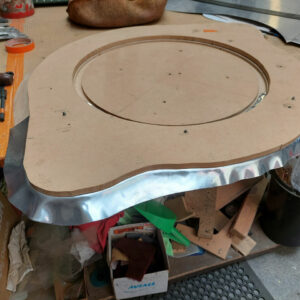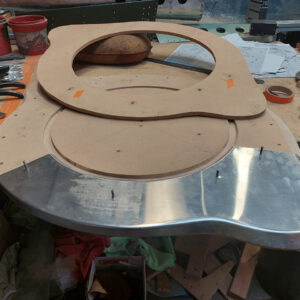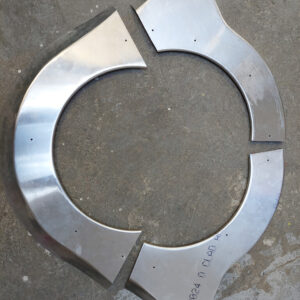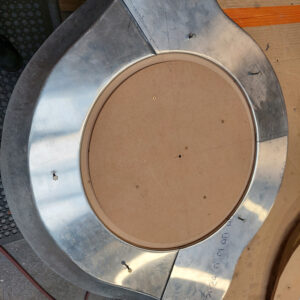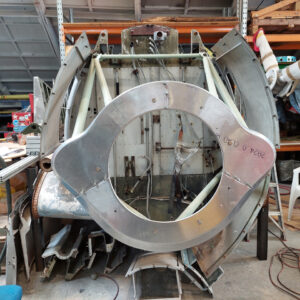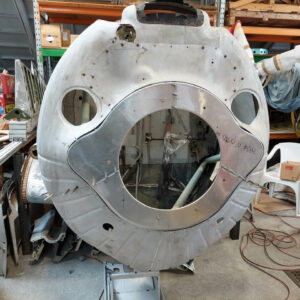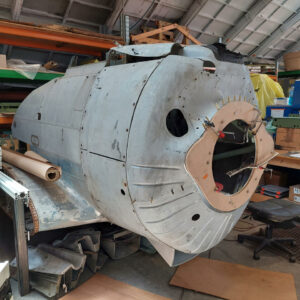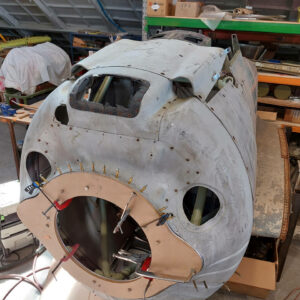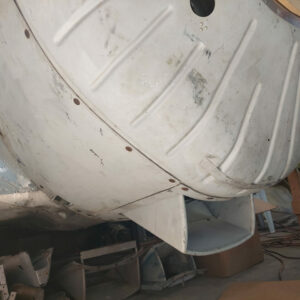Amongst the components shipped to New Zealand was the partial fuselage from Douglas RA-24B Banshee 42-54593, an Army Air Forces variant of the Dauntless. The MGM movie studio once used this airframe, along with a number of other examples, to simulate wind on their film sets when needed. While the film company had cut away most of the fuselage during their wind-machine modifications, the firewall bulkhead was still very much intact. This offered the perfect opportunity for Pioneer to work on the firewall-forward parts of the Dauntless while they awaited the arrival of our SBD-5 fuselage.
After applying anti-corrosive paint to the engine mount, which was in exceptional condition, technicians attached it to the A-24's firewall to begin the process of building up the engine section and associated paneling.
Pioneer began this effort by first working on the “Dish Pan” (an informal name for the pan-shaped diaphragm which attaches to the engine mount right behind the exhaust manifold). This sheetmetal structure acts as a heat shield for the more temperature-sensitive items in the engine accessory compartment immediately behind it.
BuNo 36175's dish pan had absorbed significant damage during the January 1944 crash, but thankfully, the example which came with the A-24 was in much better condition. The center seal section, however, was absent so Pioneer had to manufacture its replacement.
The engine bearer primed with expoxy primer to protect it until the top coat color can be applied. (image via Pioneer Aero)
The engine bearer fitted to the "Hollywood wind machine" that Pioneer is using to set up the firewall-forward components. This section of forward fuselage is in amazing original condition. The A-24's fuselage section is mounted on four steel legs to provide a stable platform to work with. (image via Pioneer Aero)
The dish pan only had minor issues to deal with. It will need new anchor nuts and Dzus springs, treatment for mild surface corrosion, and minor dents addressed. As already noted, the center seal was missing, so Pioneer had to manufacture a replacement. To perform this task, the team first fabricated a forming block from MDF (an inexpensive, easily machinable wood fibre composite). They determined the appropriate size and shape using a combination of the available dish pan sections and scaling up the original SBD drawings.
The team then cut three sections of untempered aluminum sheet (2024 T0) to approximately the correct size for the new component and then began shaping these over the MDF former by hand using a variety of planishing hammers and a shrinker. Once all three sections were in the proper shape, the technicians trimmed the edges to the correct size and positioned the parts to interlock with one another.
Fabricating the MDF forming block to allow the fabrication of a new central seal for the dishpan. In this image, the technician is shaving the edges to the correct profile. (image via Pioneer Aero)
One of the three sheet metal blanks in place on the forming block ready to begin shaping the part for the dish pan's center seal. Note the backing block for the forming block sitting at the top right of the image. This will be firmly affixed over the new metal to stop it buckling in inappropriate places. (image via Pioneer Aero)
The new part taking shape. Firmly wedged between the two pieces of MDF, the part is beaten around the edges with various types of planishing hammers and mallets. Periodically, the part will be removed from this set up for additional work in a metal shrinker. (image via Pioneer Aero)
This shows one of the parts for the dish pan inner seal following the completion of the main forming process. (image via Pioneer Aero)
The three parts which make up the center seal in the dish pan are properly formed in this image. They now need to be trimmed to size, with joggles pressed into the edges where they meet to allow a flush interface. (image via Pioneer Aero)
The new center seal was then offered up to the original dish pan sections to check the fit; only minor adjustments were required to get them to match each other properly. This then allowed mounting holes to be drilled into the newly-made parts so that they would line up properly with the other components. With everything being checked for fit, the team then mounted the rear cowling sections, which are all original, Douglas-built parts. It is so exciting to see everything line up perfectly! Note the conformal gun ports in the upper cowlings for the SBD's nose-mounted machine guns.
While each of these cowling sections came from the A-24, they are essentially identical to those found on an SBD-5. BuNo 36175 lost its own units when it ditched in Lake Michigan back in 1944.
The three newly-manufactured sections of the centre seal fitted to the engine mount. The attachment holes were drilled using the drawing dimensions but they matched the bearer perfectly. (image via Pioneer Aero)
Offering up the newly-manufactured inner seal to the original dish pan sections to begin the process of drilling the holes to attach them to the original sections. (image via Pioneer Aero)
Drilling the mounting holes in the flange for the newly-manufactured centre seal so that they match the holes on the original dish pan sections. Clamping the backing block onto the forming block helps keep everything properly aligned and straight. Note the rear (accessory section) engine cowls are fitted. These are all original and all fit. This ensures that the relationship between the firewall and the dish pan is correct. (image via Pioneer Aero)
Another shot of the dish pan assembly during the mounting hole drilling process for the centre seal flange. The top engine cowl is a good fit as well! (image via Pioneer Aero)

